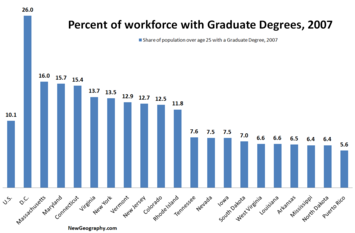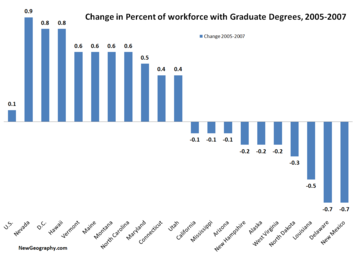
At a time when national unemployment is rising, Nebraska is working overtime to attract labor. At the inaugural Sarpy County Economic Summit, Governor David Heinemann (R) talked about the need to “market the state to 16- to 20-year-olds.” Nebraska, apparently, has more jobs requiring college degrees than it has college graduates. (Interested college students can call the Director of the Nebraska Department of Economic Development, Richard Baier, at 402-471-3746.)
Special incentives are in place for any employer who will bring in jobs that will drive up the average local salary. The idea is to keep young college graduates here by bringing in better jobs.
Nebraska is not alone in this regard. In the middle of all the economic turmoil, the Federal Reserve districts in Cleveland, Chicago and Kansas City reported high demand and resulting upward pressure on wages for skilled labor. The industries most in need of additional skilled workers are energy, health care, and manufacturing. Yes, manufacturing. Skilled financial services workers were easier to come by in Dallas as a result of mergers in the industry. The same was true for financial workers in Chicago. The only minimum-wage jobs going wanting are in the leisure and hospitality industry in the Kansas City district.
 I did an analysis comparing States (plus Puerto Rico and D.C.) by the high percentage of workers with graduate degrees in 2007 and the change in that figure from 2005. For example, Nevada ranked 45th among the States for workforce with graduate degrees in 2007; yet they ranked number 1 for increasing that percentage since 2005 (from 6.6% to 7.5%). The Knowledge Score is simply the difference in the two ranks. Nevada has the highest score at 44. The States with the lower scores are falling behind: although they rank high this year other states are moving up faster in gaining educated knowledge workers. Delaware has a score of -37: they rank 15th for an educated workforce but next to last (better only than New Mexico) for going from 11.1% of the workforce with graduate degrees in 2005 to 10.4% in 2007.
I did an analysis comparing States (plus Puerto Rico and D.C.) by the high percentage of workers with graduate degrees in 2007 and the change in that figure from 2005. For example, Nevada ranked 45th among the States for workforce with graduate degrees in 2007; yet they ranked number 1 for increasing that percentage since 2005 (from 6.6% to 7.5%). The Knowledge Score is simply the difference in the two ranks. Nevada has the highest score at 44. The States with the lower scores are falling behind: although they rank high this year other states are moving up faster in gaining educated knowledge workers. Delaware has a score of -37: they rank 15th for an educated workforce but next to last (better only than New Mexico) for going from 11.1% of the workforce with graduate degrees in 2005 to 10.4% in 2007.
The Minneapolis district “reported continued strength in professional business services.” Our analysis scores them 2, meaning they are currently attracting a more educated workforce. In contrast, San Francisco and Philadelphia reported that “demand for professional business services was down.” I score California at -30 and Philadelphia at -14, meaning that they are losing their educated workforce. It’s likely that knowledge workers are leaving because of the lack of opportunity and, in California especially, high housing costs.
Although Illinois ranked 12th among the states for percentage of the workforce with graduate degrees, their increase from two years ago was about the national average, giving them a Knowledge Score of -21. The demand for skilled labor in manufacturing, healthcare, and some professional services remained strong in the Chicago Federal Reserve district, which will put upward pressure on wages. These higher wages will serve to attract more knowledge workers to the State. The Chicago district, which includes northern Illinois, southern Wisconsin, southern Minnesota, Michigan, and northern Indiana, reported shortages of skilled workers. Among the States included in the Chicago district, only Wisconsin and Indiana have positive Knowledge Scores.
The relationship between education and income is well-known. The median-income in the U.S. was $33,452 for 2007, about what is earned by the worker with some college or an associate’s degree. Workers with only a high school diploma make about 20% less than that. A bachelor’s degree translates into a 40% increase in income; a worker with a graduate degree earns 83% more than the median-income. And this curve gets steeper every year: from 2006 to 2007 the slope increased 3%.
 So where are the knowledge workers going to and coming from? Nevada, Hawaii and DC lead the way in attracting them while New Mexico, Delaware and Louisiana are the biggest losers. Actually, only 10 States are losing knowledge workers as a percent of the workforce, including North Dakota, West Virginia, New Hampshire, Alaska, Arizona, California and Mississippi. In addition to educating the workforce, the U.S. also benefits from international migration. In the face of some of these shortages for skilled-labor, US immigration routinely increases the allowance for workers in industries like technology and others requiring advanced education. However, there has been little change in the overall percentage of the US workforce with advanced degrees: 10% in 2005, 9.9% in 2006 and 10.1% in 2007. Among the many other states increasing the share of their workforce with advanced degrees, Montana, North Carolina, Maine, Vermont and Maryland led the way with increase of more than 0.5%.
So where are the knowledge workers going to and coming from? Nevada, Hawaii and DC lead the way in attracting them while New Mexico, Delaware and Louisiana are the biggest losers. Actually, only 10 States are losing knowledge workers as a percent of the workforce, including North Dakota, West Virginia, New Hampshire, Alaska, Arizona, California and Mississippi. In addition to educating the workforce, the U.S. also benefits from international migration. In the face of some of these shortages for skilled-labor, US immigration routinely increases the allowance for workers in industries like technology and others requiring advanced education. However, there has been little change in the overall percentage of the US workforce with advanced degrees: 10% in 2005, 9.9% in 2006 and 10.1% in 2007. Among the many other states increasing the share of their workforce with advanced degrees, Montana, North Carolina, Maine, Vermont and Maryland led the way with increase of more than 0.5%.
You are probably surprised to find Nevada at the top of the Knowledge Scores. From September 2007 to September 2008, Nevada decreased the overall number of jobs by 7,600. In fact, the loss of 14,300 construction jobs was offset by a gain of 7,600 jobs in health services, transportation, utilities, education, and other services. The shift is toward jobs requiring skilled workers, those with higher levels of education, the Knowledge Workers.
Down the road, it appears that the balance of knowledge workers are shifting to states that, for years, lagged behind perennial leaders like Massachussetts, California and New York. Now the balance is shifting and as the economy moves from speculation to productive jobs – such as those related to manufacturing, logistics, food and energy – we will also see an increase in new opportunities in these states for knowledge workers who are increasingly critical to these fields as well.
Susanne Trimbath, Ph.D. is CEO and Chief Economist of STP Advisory Services. Dr. Trimbath’s credits include appearances on national television and radio programs. Dr. Trimbath is a Technical Advisor to the California Economic Strategy Panel and Associate Professor of Finance and Business Economics at USC’s Marshall School of Business. Dr. Trimbath was formerly Senior Research Economist at the Milken Institute and Senior Advisor on the Russian capital markets project for KPMG.












